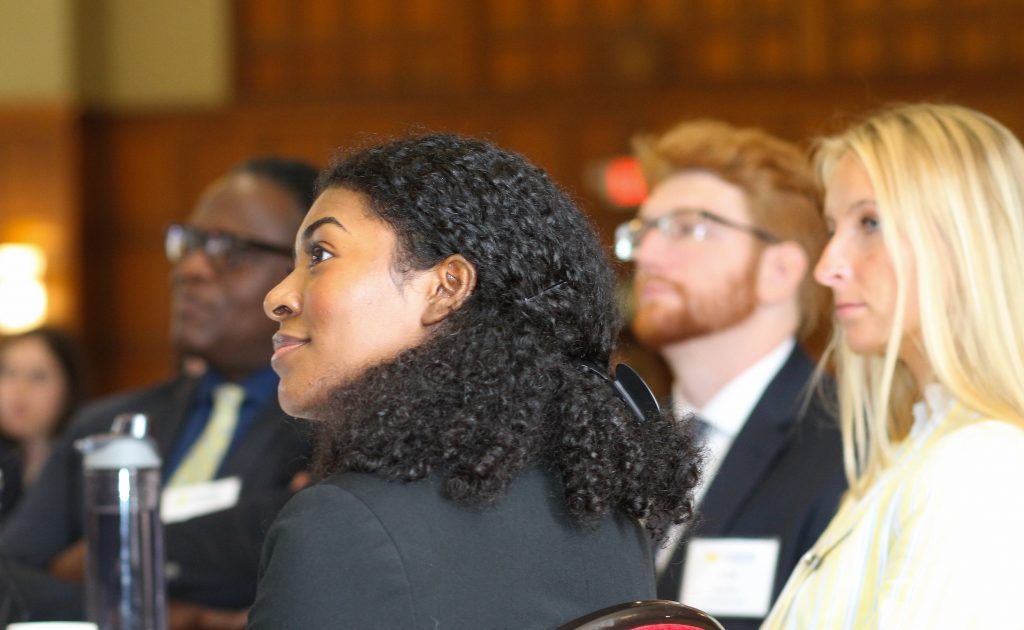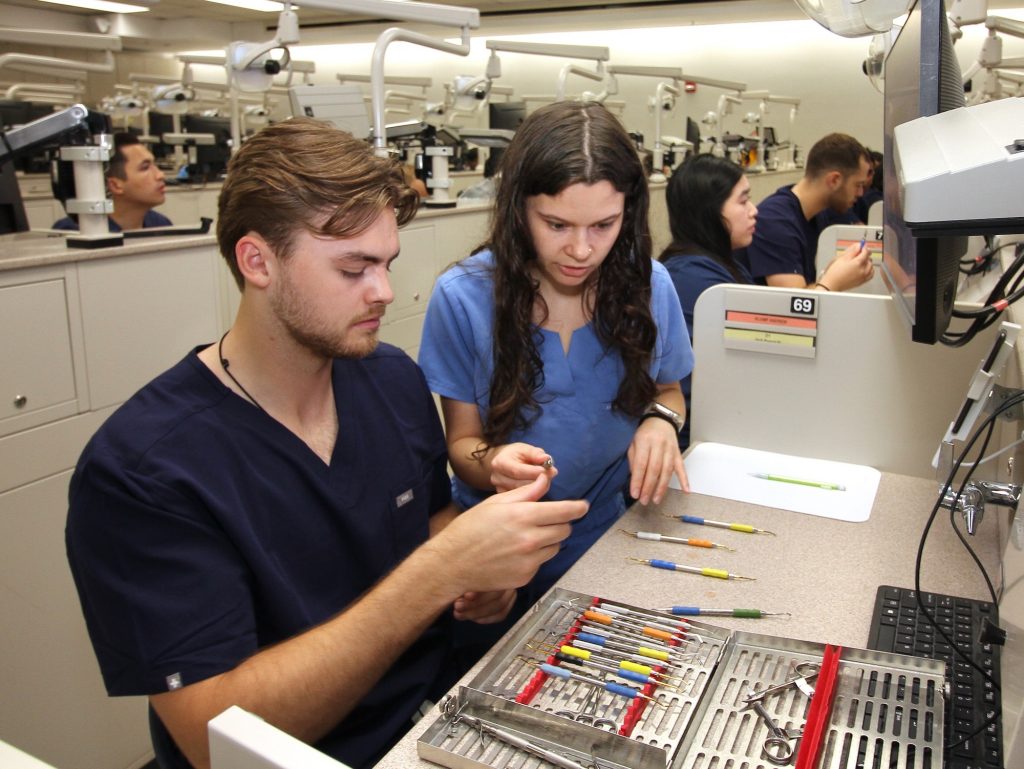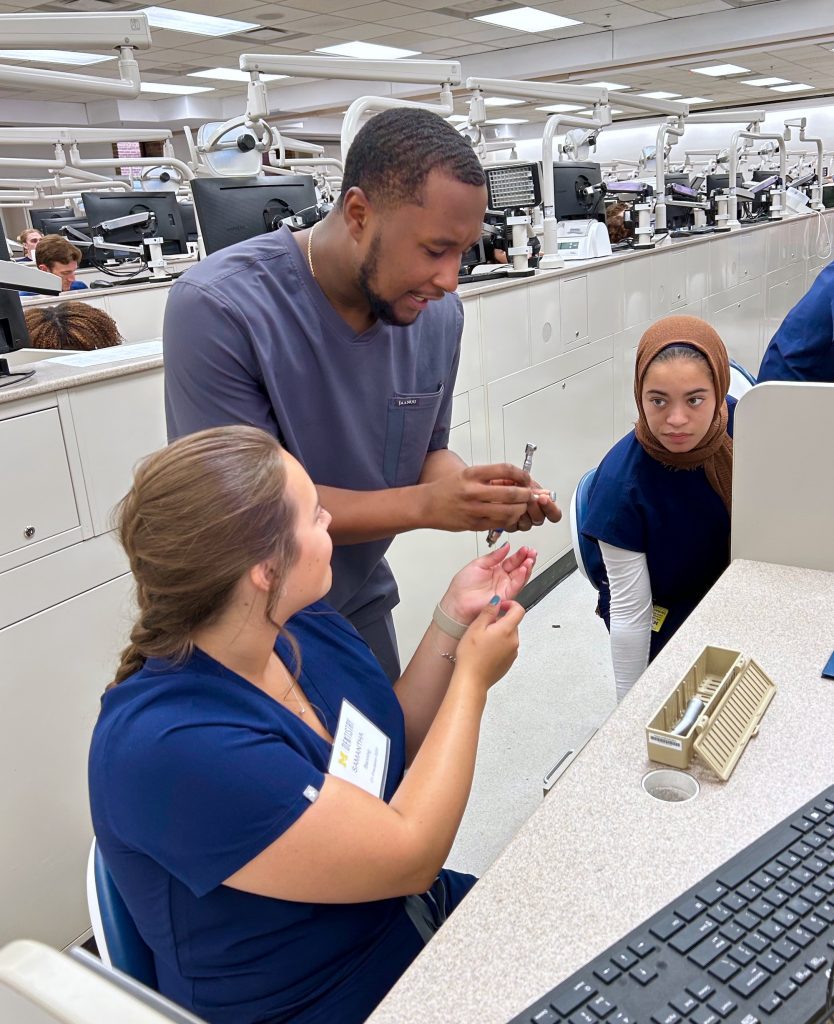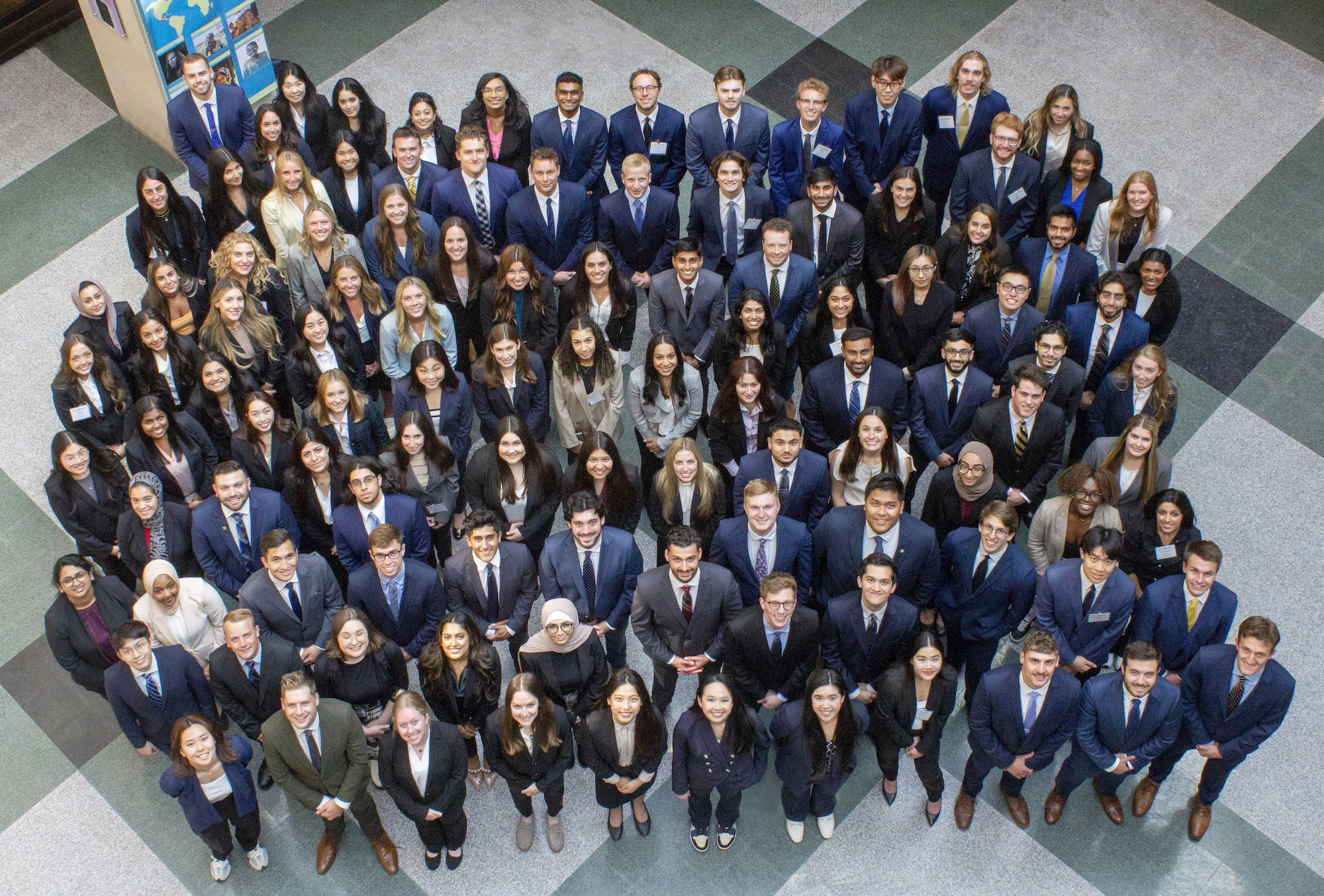New DDS students arrive, bringing together their 109 stories to comprise the Class of 202718 min read

Members of the DDS Class of 2027.
Ann Arbor, Mich., June 27, 2023 – The DDS Class of 2027 has arrived at the School of Dentistry with 109 students bringing lofty academic credentials and compelling personal stories from across Michigan and around the country.
The dental students were greeted at orientation last week with a series of introductory meetings, equipment check-outs and the start of classes.
During the first-day presentations, Interim Dean Jan Hu welcomed the class with a short history lesson about the University of Michigan and its dental school, founded in 1875. Hu noted that the new students will help the school celebrate its sesquicentennial in two years, halfway through their four-year course of study toward their Doctor of Dental Surgery degrees.

Hu noted the foundational expectations and goals that accompany the students’ time at one of the leading dental schools in the world. The school’s mission is “Advancing health through education, service, research and discovery.” The school’s core values are compassion, leadership, excellence, responsibility, trust, creativity and inclusion. The ultimate goal at the end of each student’s four years in the DDS program is to ensure that each graduate is “a highly skilled competent clinician, with a deep understanding of the scientific foundation of dentistry, and the compassion to serve those in need.”
Dr. Renée Duff, Associate Dean of Students, praised the collective academic success of the class and compared the students’ goal of becoming dentists and completing dental school to navigating a difficult mountain climb. There will be difficult parts and easy parts, with collaboration and teamwork required to meet the challenging requirements and ultimate goal. The good news, she said, is that the dental school is full of people experienced in the process and ready to step forward and assist, much like the Sherpas who help mountain-climbers in the Himalayas.
“You are surrounded by amazing Sherpas in your faculty and support staff,” she said. “We’ve been on this climb a few times. We are excited to help you navigate the path so don’t ever hesitate to reach out. We’re all here to help, especially Student Services where we aim to support your success with services from financial aid to wellness to academic support.”

Two fourth-year students, Tristan Clark and Tommy Lau, used their experiences so far to provide a discussion of advice and tips to make the academic and clinical requirements proceed smoothly over the next four years. Except, they noted, dental school is never a perfectly smooth drive; there will be bumps in the road and setbacks. The ability to be organized, ask for help, develop mentors and friends, and keep moving forward are crucial skills when students run into difficult times, they said.
Clark said the syllabus and weekly schedules are intimidating because they are packed with courses, many requirements, and seemingly few breaks. “It will all get done, some way, some how,” Clark said. “It’s going to be a big, long list. You’ll think: ‘There is so much – I don’t know how I’m going to be able to do it all.’ I promise you will. Just lean on each other and make sure you help one another. Be open and frank and friendly, and you’ll be able to do it. It’s so much better if you can work with one another, rather than trying to do it all yourself.”
The demographics of the Class of 2027 include:
• The 109 class members were admitted from 1,656 applicants.

• Continuing a trend at dental schools in recent years, significantly more entering students are women (65) than men (44) in what has been historically a male-dominated profession prior to the passage of federal Title IX legislation in the 1970s.
• 60 class members are from Michigan and 49 are from out-of-state.
• Michigan universities represented in the students’ undergraduate preparation are the University of Michigan, Ann Arbor, University of Michigan, Dearborn, Michigan State University, Wayne State University, Grand Valley State University, Hope College, Calvin College, Central Michigan University, Oakland University, Alma College, Aquinas College, Eastern Michigan University, Ferris State University, Northern Michigan University, Saginaw Valley State University.
• Students in the class also graduated from colleges and universities in these states from coast to coast: Arizona, California, Florida, Georgia, Illinois, Indiana, Kansas, Kentucky, Massachusetts, Minnesota, Mississippi, Nebraska, New Jersey, North Carolina, Ohio, Pennsylvania, Texas, Utah, Washington and Wisconsin. One student graduated from a university in Canada.
• 14 percent of the class are first-generation college students.
• The undergraduate Grade Point Average of the class is 3.81.
• Five of the class members have a master’s degree in addition to their bachelor’s degree.

––––––––––––––––
Following are short biographies and a video of several students in the new class that illustrate the wide-ranging journeys of students who enroll at the U-M School of Dentistry.
–––––––––––––––––
Frida Sandoval, from Detroit, Michigan; undergraduate degree from the University of Michigan: The Detroit resident is among the class members who are the most familiar with the School of Dentistry after she was part of the University of Michigan’s Health Sciences Scholars Program while earning her undergraduate degree. The program is a learning community that helps students explore various health science careers. A first-generation college student, Sandoval studied evolutionary anthropology and conducted lab research in that field while also shadowing various professional units on campus, including the dental school, medical school and social work, among others.

That she ultimately chose to pursue dentistry may be linked in hind-sight to a seed planted by a teacher she had in high school for a favorite art class in jewelry-making. Knowing that Sandoval was thinking about her future plans, the teacher told her: “You should do dentistry. It’s like doing jewelry in somebody’s mouth.” She remembered that advice as she learned more about dentistry and saw the U-M School of Dentistry in action during her undergraduate years. Ultimately, she chose the dental school she was most familiar with, in part because she wanted to attend a school with a community of people with a wide variety of cultural backgrounds.
“They covered so many things that I wanted to learn going into dentistry and they had so many programs specifically for DEI (Diversity, Equity and Inclusion) that I felt more welcome,” she said. “I’m a person from a Mexican background, so for me it was very important to be acknowledged that I had that background. And also, I’m a first-generation (college student) so I didn’t have a lot of exposure to dentistry. Meeting a lot of DEI faculty at the dental school was a sure indicator that this is definitely a school that wants me to be here. And I’m just happy to be here when I am here. It’s all of these people – faculty, staff and students – who make you feel very welcome and at-home. The DEI factor is really strong here and I know that they value it.”
Sandoval said she hopes to return to Detroit after earning her DDS degree because there is a need. “There are a lot of health disparities, especially in the large cities,” she said. “I want to definitely go back to Detroit and give back to my community and be able to serve people in the immigrant population. They are specifically who I want to help and make dental care more accessible to them. I want to build bridges between the people from my community and dentistry.”
Brendan Elliott, from Marquette, Michigan; undergraduate degree from Gustavus Adolphus College: Elliott is from a family of dentists, but first he decided to pursue his hockey dreams, leaving home at age 15 for various hockey schools and leagues around the country and Canada. He loved his time playing in Arizona, Minnesota, Wisconsin, Ontario, New Hampshire, Boston and Philadelphia. When he finally entered college at age 20, he chose Gustavus Adolphus, a small college in St. Peter, Minnesota, where he played defenseman on its Division III hockey team. Balancing the rigorous academics of the college with the demands of a college hockey team taught Elliott about being organized, planning ahead and navigating with little sleep at times. “It was more challenging than I anticipated, but it was a great spot for me for four years.”

When he graduated, he spent a gap year coaching one of the hockey teams that he had played for, in Milwaukee, Wisconsin. Then it was time to make a decision about his future. Elliott is from a Michigan Upper Peninsula family with strong dentistry connections to the U-M dental school. His maternal great-grandfather was Thomas F. Robinson, who practiced in Sault Ste. Marie. Elliott’s grandfather, Thomas G. Robinson earned both DDS and MS in orthodontics at U-M and practiced with his father in the Sault. Thomas G.’s son T.J. Robinson (Elliott’s uncle and the brother of his mother, Jill) has the same two-degree pedigree; he practices in Ohio and is an adjunct orthodontics faculty member at the U-M dental school. T.J.’s daughter, Kiera, (Elliott’s cousin) graduated from the U-M dental school last year.
Elliott grew up in Sault Ste. Marie and visited his grandfather’s dental practice often, so he was always aware of the family’s dentistry history. “It seems to run in the family,” he says, flashing a smile with his intentional understatement. “It was certainly always there. What it took for me was to sit down and make a decision. I needed to know what I was going to do after hockey. Once I really sat down and thought through it, (dentistry) was the right choice.”
Elliott’s hockey journey was influenced by his father’s history as a hockey player at Michigan State University. “I kind of followed his footsteps with my hockey and now I’m following the other side’s footsteps with dentistry,” he says. He plans to focus on general dentistry first, before considering various specialties, including his family’s focus on orthodontics. “I want to get a taste of everything and see for myself,” he says.
Alia Echols, from Bartlett, Illinois; undergrad degree from Mississippi State University: Location is important to Echols. For her undergraduate studies, she wanted to go somewhere warm and it helped that her mother had attended Mississippi State, so that was her choice. For dental school, she wanted to stay relatively close to her home in Bartlett, a suburb northwest of Chicago, and she wanted a school with a comprehensive emphasis on various specialties.

“I really wanted to pick a dental school that could introduce me to the different residencies. It had to have orthodontics and pediatrics because those are my main two interests” she said. “And also I wanted a school close to home so I could go home on the breaks. Those were really my main two – location and what’s offered through the program, such as Pathways, which is awesome.”
She learned about the school’s Pathways Program during the interview process. The program allows students to study areas they are interested in outside the traditional dental school curriculum, through either research or didactic courses. Echols said U-M’s interview process, called MMI for Multi Mini Interviews, was the most exciting of her dental school interviews because it was conversational with lots of people at the school, including faculty, which provided enough information for her to get a feel for the school. “Interacting with them, and seeing the group I was in with, I just knew that I belonged here,” she said.
Asked what makes her unique among her classmates, Echols cites two distinctions – she has a twin brother and a sweet tooth. Regarding the latter, she says: “That’s kind of odd for a dentist, but I make it work.”
Jackson Watkins, from Idaho Falls, Idaho; undergraduate degree from Brigham Young University-Idaho: Watkins came to dentistry late after preparing to go to medical school for the first three and a half years of his undergraduate studies.
“I was in the middle of studying for the MCAT (Medical College Admission Test) and I knew something wasn’t right,” he said. “I was shadowing so many different physicians and no one talked highly about the profession. No one recommended me to do it, not a single one, and it was really disheartening. And I thought, I’ve come this far, I love science, I love helping people, I love healthcare, but I know medicine isn’t for me.” So he called his dentist and asked if he could observe at his dental practice.

“It was an awesome experience. He actually talked highly of the profession and recommended that I do it. I shadowed a few other dentists and specialties, and it was the same story. I could tell that they loved what they do. So I switched from studying for the MCAT to studying for the DAT (Dental Admission Test). And in less than a year’s time, I applied to dental schools and all the pieces fell into place. I don’t have any regrets at all.”
Watkins said accepting admission to U-M was a “no-brainer” given its recently renovated facilities with the latest technology and equipment, its leading research credentials, more affordable out-of-state tuition than many other schools, and the people he met during the admissions process. Given his pre-med focus for most of his undergraduate years, Watkins said he will be learning about his dental career options as he goes. He has accepted a Health Professions Scholarship Program from the U.S. Navy, so he knows at least the first four years after he graduates he will practice dentistry in the military.
“Everything I did pretty much whole life was leading me up to be a physician, and at the last minute it changed for me,” he said. “I’m new to dentistry. I probably know less than anyone else here, but I’m real excited to get into it.”
• Anne Pham, from Boston, Massachusetts; undergrad degree from University of Massachusetts Boston: Pham’s path to dental school started when she attended an organization fair halfway through under undergraduate studies at the UMass – Boston. She knew some of the students in the pre-dental club, so she decided to join. After various pre-dent activities, including making wax models and working with amalgam, she was interested in the career.

Pham applied to 17 dental schools and chose U-M for several reasons, including the quality of the interviewing process and in part because U-M reached out to her first. She liked the school’s Pathways program that lets students immerse themselves in courses or research that are of particular interest to them as individuals, beyond the collective dental school requirements. With Pham, that could be art.
She said dentistry has similarities to her longstanding interest in art. She took drawing and print-making classes in college as a de-stressing mechanism and alternative to her biology major. Her artistic interest extends to her pastime of modifying sneakers by adding different materials and colors to the original design, mostly for herself but a few for other people. She sees a link to the materials science involved with different substances used in the dentistry process. “When you are doing restorations with composites, you are layering different colors, you are looking at translucency, and you are also looking at form and structure. So that has similarity to sculpture.”
Ben Kelly and Isabel Hanson, both from Gladstone, Michigan; Ben’s undergrad degree is from Michigan State University and Isabel’s is from the University of Michigan: Ben and Isabel have the distinction of starting two major life stages within nine days of each other. They were married June 10 and on June 19 started dental school in the U-M Class of 2027. They’ve known each other since their middle school days in Gladstone, Michigan, in the Upper Peninsula.
Ben comes from a family full of dentists and he knew early on that he would likely carry on the tradition. Isabel came to the career much more recently. During their time apart for undergraduate degrees, they discussed what sort of health sciences field she was interested in pursuing. Citing her science background, he asked, “Why not dentistry?” She thought about it and decided they would become a dual-dentistry couple.

As they applied to dental schools, they hoped they would be accepted to schools that were geographically close, but the final result was even better – both were accepted to U-M. Once they knew where they would be for the next four years, getting married seemed like the natural progression. Isabel said arriving for dental school orientation as a married couple has helped reduce the anxiety of starting dental school since they will have each other as sounding boards and study partners, even though it will be important to build academic bonds with many other classmates as well.
Ben’s great-grandfather, George Kelly, started the family tradition of dentistry and attending the U-M dental school, followed by both of Ben’s grandfathers – Mike Kelly and Nelson Smith. Ben’s father, Scott Kelly, also a U-M alumnus, is carrying on the family dental practice in Gladstone. Ben and Isabel say they plan on returning to Gladstone for both family tradition and practical reasons. Dentists across the U.P. are concerned that not enough new dentists are interested in moving north to replace upcoming retirees in the state’s least-populated region, despite its many quality-of-life advantages related to the great outdoors and the Great Lakes.
Ben and Isabel plan to be part of the solution. “There’s a shortage of dentists up there … there is such a huge need up there,” Ben said. “I wouldn’t feel good about not doing it, honestly. It feels like what we should be doing.”
###
The University of Michigan School of Dentistry is one of the nation’s leading dental schools engaged in oral healthcare education, research, patient care and community service. General dental care clinics and specialty clinics providing advanced treatment enable the school to offer dental services and programs to patients throughout Michigan. Classroom and clinic instruction prepare future dentists, dental specialists and dental hygienists for practice in private offices, hospitals, academia and public agencies. Research seeks to discover and apply new knowledge that can help patients worldwide. For more information about the School of Dentistry, visit us on the Web at: www.dent.umich.edu. Contact: Lynn Monson, associate director of communications, at [email protected], or (734) 615-1971.


